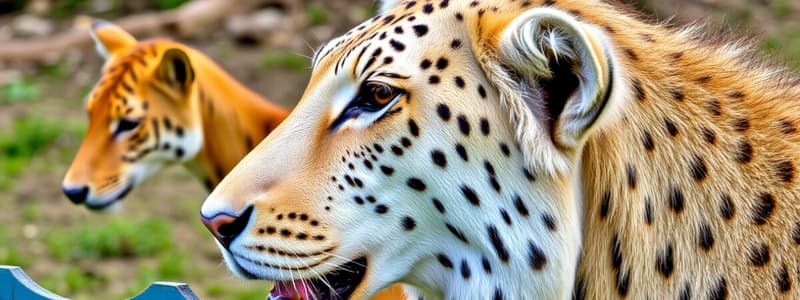Podcast
Questions and Answers
What is one of the primary criteria used in the domestication process?
What is one of the primary criteria used in the domestication process?
- Development of territorial instincts
- Selective breeding for desirable traits (correct)
- Increased solo foraging behavior
- Adaptation to extreme climate changes
Which animal is recognized as the first domesticated species?
Which animal is recognized as the first domesticated species?
- Goats
- Cattle
- Cats
- Dogs (correct)
What impact did domestication have on human societies?
What impact did domestication have on human societies?
- Shift to settled agriculture (correct)
- Increased nomadic lifestyles
- Decline in agricultural productivity
- Diminished population growth
Which of the following species is NOT traditionally associated with early domestication for food or labor?
Which of the following species is NOT traditionally associated with early domestication for food or labor?
What is one of the challenges associated with modern domestication?
What is one of the challenges associated with modern domestication?
Flashcards are hidden until you start studying
Study Notes
Animal Domestication
-
Definition: Process of adapting wild animals for human use, including companionship, labor, food, and clothing.
-
Timeline:
- Began around 15,000 years ago.
- Early evidence found in regions like the Middle East, Asia, and Europe.
-
Key Species:
- Dogs: First domesticated animal; evolved from wolves; used for hunting and companionship.
- Sheep: Domesticated for meat, wool, and milk; early evidence in the Fertile Crescent.
- Goats: Similar to sheep, domesticated for milk and meat; versatile in various environments.
- Cattle: Domesticated for labor, milk, and meat; evolved from aurochs.
- Pigs: Domesticated from wild boars; raised for meat and adaptability to various diets.
- Horses: Domesticated for riding, transportation, and labor; enabled advancements in trade and warfare.
-
Domestication Process:
- Selection: Humans selectively bred animals with desirable traits (docility, size, behavior).
- Behavioral Changes: Domesticated animals often show reduced aggression and increased sociability.
- Genetic Changes: Domestication leads to phenotypic changes (size, color, morphology).
-
Benefits of Domestication:
- Reliable food sources (meat, milk, eggs).
- Enhanced agricultural productivity (labor animals).
- Companionship and protection (dogs).
- Economic surplus and trade opportunities.
-
Impact on Human Society:
- Shift from nomadic lifestyles to settled agriculture.
- Development of complex societies and civilizations.
- Changes in diet and nutrition, contributing to population growth.
-
Modern Domestication:
- Continues with species like cats, rabbits, and various birds.
- Ethical considerations around breeding practices and animal welfare.
-
Challenges:
- Loss of genetic diversity in domesticated species.
- Dependency on a few domesticated species for food security.
Animal Domestication
- Definition: Adapting wild animals for human purposes such as companionship, labor, food, and clothing.
- Timeline: Domestication began approximately 15,000 years ago, with early evidence found in the Middle East, Asia, and Europe.
Key Species
- Dogs: The first domesticated animal, evolved from wolves; primarily used for hunting and as companions.
- Sheep: Domesticated for meat, wool, and milk, with early examples found in the Fertile Crescent.
- Goats: Domesticated for milk and meat; they are adaptable to various habitats.
- Cattle: Bred for labor, milk, and meat, descended from aurochs.
- Pigs: Derived from wild boars, domesticated for their meat and ability to thrive on diverse diets.
- Horses: Domesticated for transportation and labor; played a crucial role in enhancing trade and military endeavors.
Domestication Process
- Selection: Humans engaged in selective breeding to enhance traits such as docility, size, and behavior.
- Behavioral Changes: Domesticated animals typically exhibit lower aggression and higher sociability compared to their wild counterparts.
- Genetic Changes: Domestication can result in significant phenotypic alterations, including changes in size, color, and morphology.
Benefits of Domestication
- Provides reliable food sources, including meat, milk, and eggs.
- Enhances agricultural productivity through the use of labor animals.
- Offers companionship and protection, notably through domestic dogs.
- Fuels economic surplus, enabling trade and growth of economies.
Impact on Human Society
- Encouraged a transition from nomadic lifestyles to settled agricultural communities.
- Facilitated the emergence of complex societies and civilizations.
- Altered diets and improved nutrition, contributing to population increases.
Modern Domestication
- Continues with species like cats, rabbits, and various birds, adapting to contemporary human needs.
- Ethical concerns arise around breeding practices and animal welfare.
Challenges
- Loss of genetic diversity poses risks to domesticated species.
- There is an increasing reliance on a limited number of domesticated species for global food security.
Studying That Suits You
Use AI to generate personalized quizzes and flashcards to suit your learning preferences.




